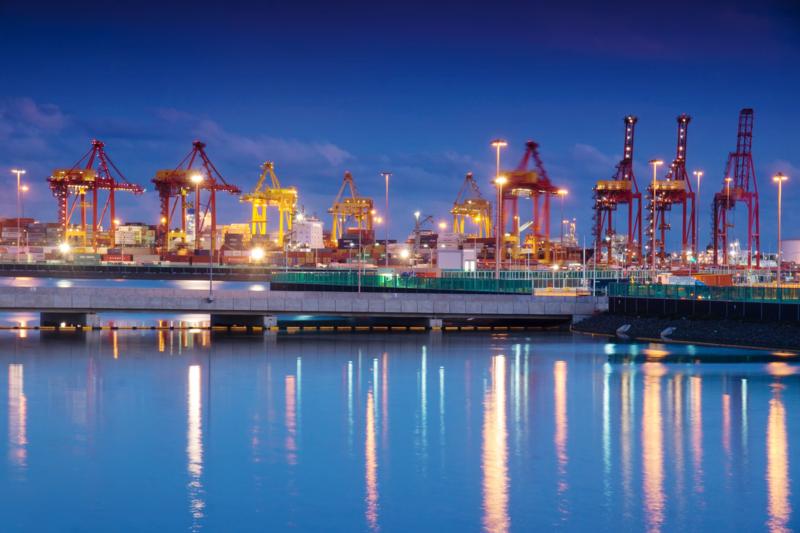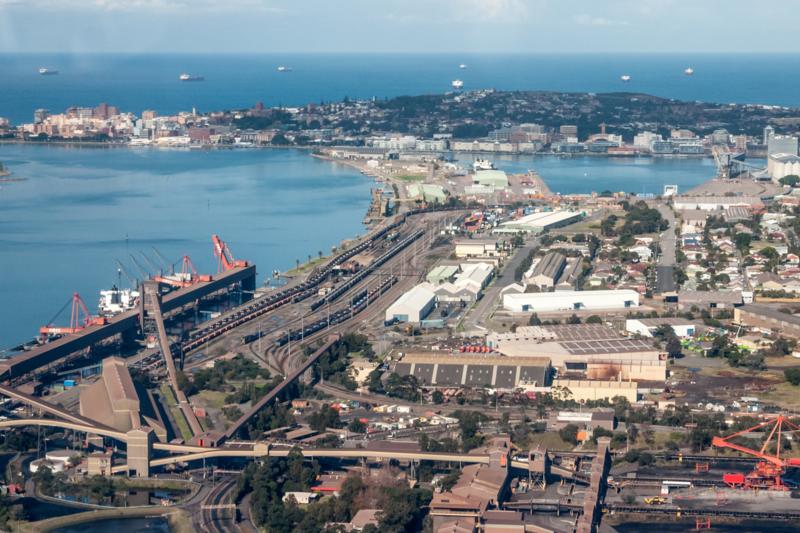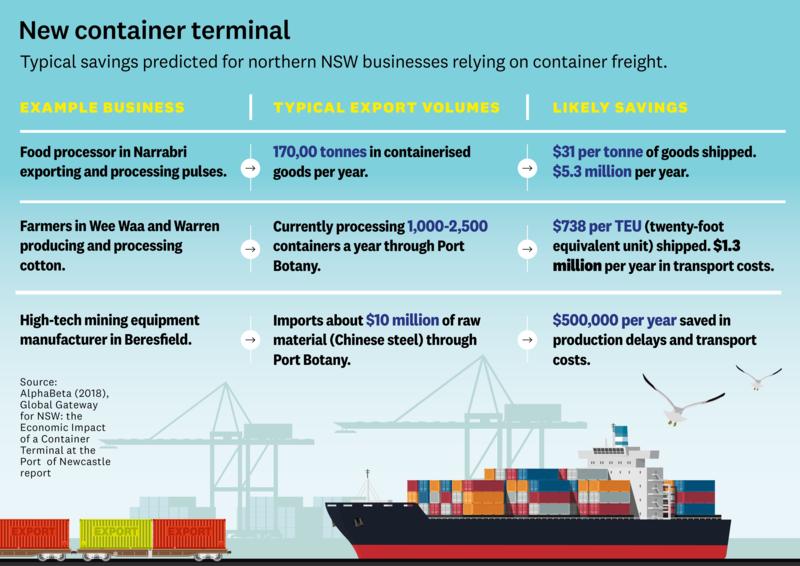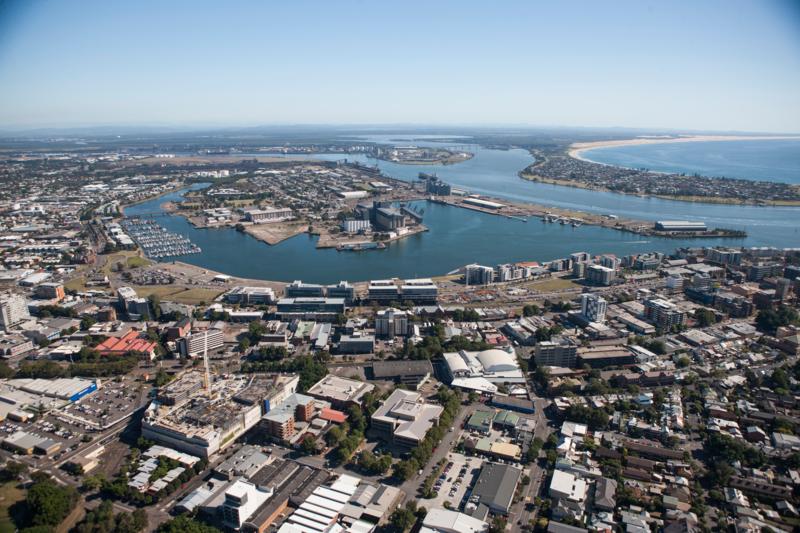WHETHER you’ve driven in Sydney or not, you likely shudder at the thought of fighting traffic congestion to get from one side of the city to the other.
For freight operators, it’s a similar situation getting containers to and from Sydney’s Port Botany, whether by road or rail. Freight is competing with passenger trains for space on rail lines and often goes to a hub to be transferred onto trucks, for the last leg anyway. Any delays could see ships leave without their cargo.
RELATED:
Proposed unified freight rail network would slash farmers' costs
It’s one of the reasons NSW Farmers is getting behind efforts to build a container terminal at the
Port of Newcastle – something it’s estimated will save $16-$22 per tonne on rail freight from northern NSW.
Grain grower Rebecca Reardon says any savings should go back into the pockets of growers. “Generally our prices are dictated by world export parity, hence our supply-chain costs are a key determinant of our farmgate return. We need an efficient and competitive supply-chain path,” Rebecca says.
 Rebecca Reardon, NSW Farmers board member, is a grain grower who is a big supporter of a container terminal at Newcastle. Photo by: Nick Cubbin.
Rebecca Reardon, NSW Farmers board member, is a grain grower who is a big supporter of a container terminal at Newcastle. Photo by: Nick Cubbin.
“Having a container terminal at Newcastle will mean a shorter trip for a lot of freight that currently goes straight past to Sydney, will avoid Sydney bottlenecks and congestion, will avoid double-handling at intermodal terminals, and will decrease trucks on the road in favour of rail.”
Rebecca is on the NSW Farmers’ board and farms east of Moree in North West NSW. She and her husband supply cotton, high-protein wheat and chickpeas for the container export market. She’s excited by the potential on offer if the new terminal is built.
“Container trade is one of the strongest growth areas for grain exports and, more generally, is expected to increase dramatically,” Rebecca says. “Container ships are getting bigger to cut costs and we need ports that can take these new Maxi vessels and infrastructure that maximises wharfside and landside productivity and vessel turnaround.
“Port Botany is already congested and a lot of the freight is coming from or is destined for northern NSW anyway. Having additional capacity closer to home will encourage growth, provide significant savings, and benefit regional communities.”
 The heavily congested port at Botany, in Sydney would be eased with a container terminal at Newcastle and potentially bring down prices. Source: Getty Images.
The heavily congested port at Botany, in Sydney would be eased with a container terminal at Newcastle and potentially bring down prices. Source: Getty Images.
The Port of Newcastle has a vacant site at Mayfield with direct water frontage and the potential for deep-water berthing, which it wants to develop into a two million TEU (twenty-foot equivalent unit) terminal.
A potential stumbling block has been Port Commitment Deeds signed when Port Botany, Port Kembla and the Port of Newcastle were privatised – now the subject of legal action by the Australian Competition and Consumer Commission (ACCC).
The deeds contain provisions that would effectively see the Port of Newcastle compensating Port Kembla and Port Botany if it developed a container terminal above a specified capacity. The ACCC is alleging this is anti-competitive and makes the development of a container terminal at Newcastle uneconomic.
Rebecca says it’s pleasing to see the ACCC take action, as any anti-competitive behaviour could deter development of the terminal and be detrimental to the interests of growers in northern NSW.
“At the end of the day, we just want to make sure transport and related supply-chain costs are as low as possible, whether that’s selling our products overseas or getting imports to rural and regional communities.”
According to Port of Newcastle CEO Craig Carmody, the government commitment to new transport infrastructure to support Port Botany’s growth is around $11 billion in direct support and more than $27 billion in broader transport upgrades. Craig says Newcastle has the capacity to handle the new Maxi vessels that carry between 14,501 and 20,000 TEUs.
 Newcastle’s existing rail and port facilities would help make it Australia’s only port capable of handling the new Maxi container vessels. Source: Getty Images.
Newcastle’s existing rail and port facilities would help make it Australia’s only port capable of handling the new Maxi container vessels. Source: Getty Images.
“With the expected increase in containers, port and rail limitations at Port Botany and Sydney congestion, Newcastle makes sense for northern NSW growers and taxpayers,” Craig says.
The port is ready to become a global gateway to regional and northern NSW, says Port of Newcastle executive manager customer and strategic development Ian Doherty. “There isn’t a container terminal in the country at the moment that can take the size of newer container ships, so everyone is missing out.
“For Australia to avoid being left behind, we need ports with the capacity to handle a vessel that carries three times the current average.”
“Newcastle is already positioned to play this critical role. It has a deep channel and direct connections to road and rail infrastructure, including the ability to take 1.5km trains right to the berth. A container terminal can be built without the need for substantial public investment or additional infrastructure.
_preview.jpg) A ship being tugged at Newcastle. Newcastle is well positioned to provide another terminal port. Source: Getty Images.
A ship being tugged at Newcastle. Newcastle is well positioned to provide another terminal port. Source: Getty Images.
“Making exporting easier and more cost effective is critical to help NSW exporters take advantage of growing Asia-Pacific markets for their products. We believe the terminal would unlock economic opportunities, reduce freight costs, generate employment and expand trade opportunities.
RELATED:
-
From paddock to Asia
-
Can the China boom last?
“It would also benefit operators using Port Botany, by easing the congestion and potentially pushing down prices due to increased competition.”
A report prepared for the Port of Newcastle says freight savings for customers in Newcastle, the Hunter and northern NSW will be worth $2.8 billion by 2050, as the average freight journey in the region will be cut by 40%.
 Case studies showing the savings farmers could expect by a container terminal at Newcastle.
Case studies showing the savings farmers could expect by a container terminal at Newcastle.
Jock Carter, executive director of agricultural export company Newcastle AGRI Terminal, says a container terminal in the city would be a really good growth opportunity for his company. “While containers are only 5%-10% of our business at the moment, I’d expect about a four-fold increase if we had a more efficient supply chain.
“The biggest limiting factor at the moment is the cost of getting freight into Sydney. Part of that is the congestion – which is only going to increase as the population grows – and its impact on reliability.
“The fascinating thing about Newcastle is the existing infrastructure. You could run long, heavy trains tomorrow into the proposed container terminal site, because it has the rail and road infrastructure and corridors already in place.”
 Newcastle has a lot of existing infrastructure and is ready to include a container terminal. Source: Getty Images.
Newcastle has a lot of existing infrastructure and is ready to include a container terminal. Source: Getty Images.
Jason Ferguson, director of Southern Shorthaul Railroad, says the current system also struggles to cope with the variability of agricultural production.
“There’s been next-to zero in the way of containerised grain exports for the most recent season, but wind the clock back a couple of years and the freight task was huge.
“If we have a bumper year after a dry year or two, rail operators will struggle to get all of the required rail port windows they need to get the grain out. It might be possible to run export trains into the metropolitan intermodal terminals and let rail port shuttles or road do the final leg, but this will add $8 to $10 per tonne to transport costs.”
Fast facts about the benefits of a Newcastle container terminal
- $2.8 billion savings on freight costs by 2050 for businesses and consumers in northern NSW.
- 40% decrease in average distance freight will travel over land..
- 4,600 new jobs gained in the Hunter and northern NSW by 2050.
- $800 million increase in exports from the Hunter and northern NSW by 2050.